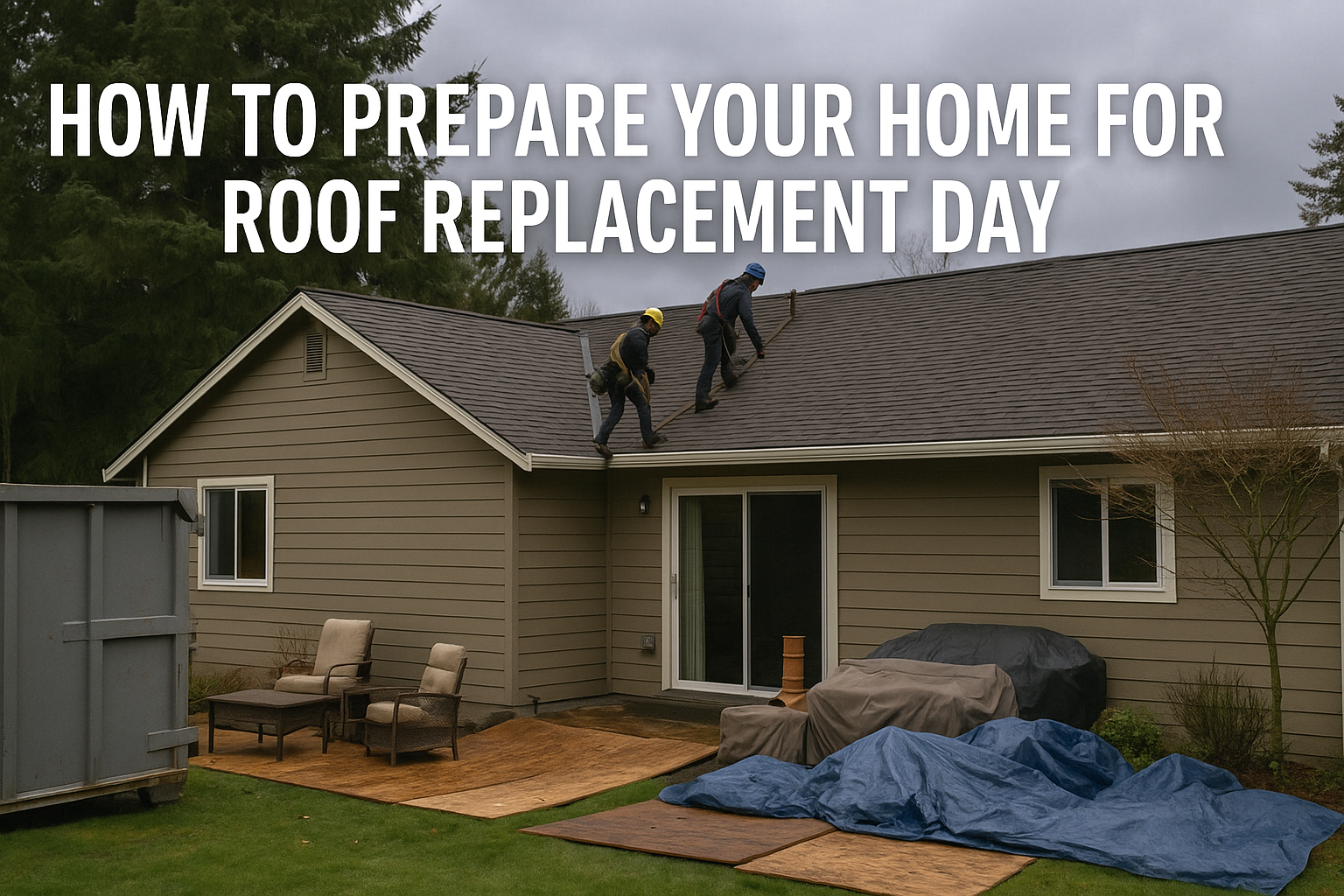A little planning the week before your roof replacement saves a lot of stress (and money) on the big day. This guide walks you through practical, homeowner-friendly steps to prepare your yard, attic, pets, landscaping—and your schedule—so the roofing crew can work safely and quickly, debris is controlled, and your home comes back cleaner than it left.
Quick checklist (print this and use it)
-
Clear driveway & park spaces for crew/skip bin
-
Move outdoor furniture, planters, grills, toys 15–20 ft from the house
-
Protect garden beds and delicate plants with plywood or tarps
-
Cover attic vents/insulation-sensitive items (see attic protection below)
-
Secure or relocate pets; post signs for crew on gates/doors
-
Remove wall-hung items near exterior doors; move garage items if needed
-
Confirm start time and contact with your project manager
1 week out: confirm logistics & expectations
-
Confirm the schedule. Ask your contractor for arrival time, crew size, estimated duration (many single-family homes take 1–3 days), and a cell number for the crew leader.
-
Plan parking and access. Free up the driveway, a nearby street spot, or a parking pad the crew can use for materials and dumpsters. A clear path reduces unloading time.
-
Talk trash & recycling. Make sure there’s a dumpster or roll-off scheduled. Discuss how the crew will handle nail pickup and roof debris.
-
Make a staging plan. Decide where the crew can store ladders, plywood, and materials—ideally on hard ground or driveway, not on lawns or flower beds.
3–2 days out: move anything fragile outdoors
-
Move outdoor items: patio furniture, potted plants, bird baths, swings, kids’ toys, grills, and hanging baskets should be relocated at least 15–20 feet from the house. If you must keep plants nearby, cover them with heavy cardboard or plywood before work starts.
-
Protect your garden: Lay plywood over garden beds or use contractor tarps anchored down. Roofing debris and falling granules can smother plants.
-
Secure landscaping: Remove or temporarily stake landscape lighting, irrigation heads, and decorative edging that might be damaged during material staging.
1 day out: attic protection & inside prep
-
Move attic-stored items away from the ceiling line. Shake or fall-through risks are small but it’s smart to relocate boxes or fragile items.
-
Cover attic insulation or sensitive stored goods with a tarp if your crew will access the attic during work. Ask the crew if they will need attic access so you can prep appropriately.
-
Inside prep: Close windows, remove wall art near exterior doors that may be opened often, and tidy the garage if it will be used for staging.
Day of installation: what to expect and do
-
Crew arrival & staging. Expect ladders, a roll-off dumpster, and bundles of shingles. Ask the crew leader for a brief walkthrough of where they’ll stage and where they expect you to park.
-
Debris control: Professionals will use tarps, plywood, and a magnetic nail sweep. Confirm this with your contractor. Keep children and pets indoors while heavy activity is happening.
-
Noise & vibration: Roofing is loud. Plan your day accordingly—if you work from home, schedule calls at another location or in a quieter room.
-
Communication: Provide the crew leader a contact number for quick decisions (e.g., move a plant, delay a delivery).
Pet safety & household coordination
-
Pets: Dogs can be stressed by loud noises; cats may hide. Consider boarding, taking dogs for the day, or confining pets to a quiet interior room. Put up signs on gates so delivery drivers and crews know pets are inside.
-
Children: Keep kids away from work zones and heavy equipment. Consider a playdate or day out for safety and to avoid disruption.
-
Neighbors: Let neighbors know in advance—material trucks, dumpsters, and parking may affect them. A quick heads-up reduces complaints.
Protecting landscaping & outdoor features
-
Plywood + tarps = protection. Lay plywood over vulnerable beds, ponds, and new plantings. Secure tarps to hold down under windy conditions.
-
Delicate features: Move small statues, fountains, and trellises indoors or to a sheltered area.
-
Lawn & irrigation: Avoid placing heavy pallets on soft lawns; direct heavy equipment to hard surfaces to prevent rutting. Mark irrigation heads to prevent accidental damage.
Debris control & cleanup expectations
-
Daily cleanup: Reputable crews remove large debris daily, not only at job end. Nails are collected using magnetic sweepers.
-
Final cleanup: Expect a thorough swipe of the roof and yard, a final magnetic sweep, and removal of tarps and protection materials. Ask for a photo-report of before/after and any problem areas the crew documented.
-
Inspect with the crew: Walk the property together before final sign-off to note any missing items or damage.
Timeline sample for a typical single-family roof replacement
-
Day 0 (pre-job): Final walkthrough and staging plan confirmed.
-
Day 1 (demo & start): Tear-off of old roofing, deck inspection, and start of underlayment. Heavy debris removed throughout day.
-
Day 2 (install): Shingle installation, flashing, ridge work, and cleanup. Final magnetic sweep and homeowner walkthrough.
-
Day 3 (if needed): Punch list fixes, final cleanup, manufacturer registration and paperwork delivered.
Common homeowner mistakes to avoid
-
Leaving fragile pots and furniture near the house.
-
Not securing pets or warning the crew about hidden bees/roosts.
-
Assuming the crew will protect plants without asking—always confirm protection plans in writing.
-
Forgetting to clear parking—delays cost time and may add to daily crew hours.
After the job: quick post-install checklist
-
Walk the property with the crew leader; check gutters, downspouts, and landscaping.
-
Ask for the final inspection report, photos, and warranty paperwork.
-
Confirm magnetic sweep receipt and dumpster removal schedule.
-
Keep the paperwork and photos in a roof file for insurance and future resale.
FAQ
Q: How long will my roof replacement take?
A: Most single-family home installations take 1–3 days depending on size, complexity, and weather.
Q: Will the crew protect my plants?
A: Many crews will if asked, but always confirm and physically protect delicate plants yourself with plywood or tarps for best results.
Q: Do I need to leave home during the replacement?
A: You don’t have to leave, but it’s often quieter and less stressful to be out of the house during the loudest work and staging.
Q: How do they handle nails and small debris?
A: Crews use tarps, magnetic nail sweepers, and hand cleanup. Verify this is part of your contract.
Final tip
Add a short pre-job meeting to your calendar the morning the crew arrives (5–10 minutes). A quick walkthrough saves time and ensures everyone agrees on staging, plant protection, and where the crew can park. That small investment of time is the easiest way to get a smooth, well-organized home roofing project.
 Call Now
Call Now Get In Touch
Get In Touch

